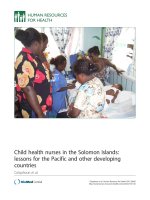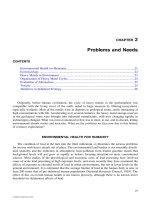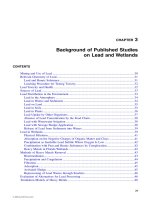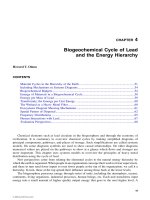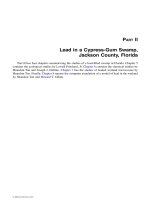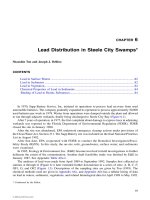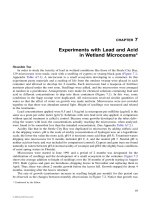Heavy Metals in the Environment: Using Wetlands for Their Removal - Chapter 5 pot
Bạn đang xem bản rút gọn của tài liệu. Xem và tải ngay bản đầy đủ của tài liệu tại đây (475.52 KB, 11 trang )
P
ART
II
Lead in a Cypress-Gum Swamp,
Jackson County, Florida
Part II has four chapters summarizing the studies of a lead-filled swamp in Florida. Chapter 5
contains the ecological studies by Lowell Pritchard, Jr. Chapter 6 contains the chemical studies by
Shanshin Ton and Joseph J. Delfino. Chapter 7 has the studies of leaded wetland microcosms by
Shanshin Ton. Finally, Chapter 8 reports the computer simulation of a model of lead in the wetland
by Shanshin Ton and Howard T. Odum.
L1401-frame-P2 Page 69 Monday, April 10, 2000 9:32 AM
© 2000 by CRC Press LLC
71
CHAPTER
5
Ecological Assessment of the Steele
City Swamps*
Lowell Pritchard, Jr.
CONTENTS
Toxicity Assessment with Planted Tree Seedlings 72
Basal Area of Tree Trunks 72
Green Leaf Area 72
Productivity of Emergent Plants 75
Metabolism of the Underwater Ecosystem 75
Invertebrate Animals 77
Indices of Biodiversity 79
Overview Conclusion 79
At the time of this study the Steele City Swamps showed varying degrees of impact, caused
less by the large quantities of lead that was filtered than by the high acidity of the battery plant
water. Figure 5.1 shows the distribution of lead in sediments, with larger values upstream and along
the pathway of water flow. At Station A (Figure 5.2) there were a few dead trees, and the wood
(in cross section) was strangely red colored. Much of the pond at B was devoid of trees but covered
in part with floating plants (
Nymphaea
). The waters were turbid with underwater objects visible
only a few inches below the surface. Gum trees were scattered at Stations C and F, but these had
just a few leaves each. In backwater areas (Stations D and H) more trees were found including
cypress. In other words, trees were absent in the areas where the most lead had been absorbed
(Figure 5.2). Station RF (reference forest) was in a pond which had not received lead wastes and
had a normal concentration of cypress and swamp black gum trees.
A limited ecological assessment was made by testing seedling survival and growth in the field,
by measuring the area of green leaves, by estimating plant productivity with two methods, and by
sampling enough underwater invertebrates to calculate indices of biodiversity. Details on the
methods are given in Appendix A5
A
.
* Condensed by the Editor.
L1401-frame-C5 Page 71 Monday, April 10, 2000 9:36 AM
© 2000 by CRC Press LLC
72 HEAVY METALS IN THE ENVIRONMENT: USING WETLANDS FOR THEIR REMOVAL
TOXICITY ASSESSMENT WITH PLANTED TREE SEEDLINGS
Tree seedlings (pond cypress, bald cypress, and swamp black gum) were planted where bare
bottoms had become exposed, measured September 24, 1990 and monitored again June 6, 1991.
In the interim there were very high water levels because of heavy rains. Since wetland tree seedlings
die if covered with water, mortality was large (Table 5.1). Surviving seedlings showed growths 10
to 30 cm. Growth and survival at station F may indicate that the sediments, although still containing
lead (Chapter 6), were not toxic to new seedlings.
BASAL AREA OF TREE TRUNKS
By measuring the diameter of live trees, the area of the trunk cross sections may be calculated,
which is called the forest basal area. Table 5.2 shows zero values in the upper stations without
trees, increasing downstream to 57 cm
2
/m
2
of land, a bit less than that in the reference forest.
GREEN LEAF AREA
In a normal wetland forest there are several layers of leaves on top of each other. The area of
leaves per area of ground below is called the leaf area index. Leaf area of the sparse tree areas was
Figure 5.1
Sediment lead concentrations in Steele City Bay, in hundreds of parts per million sediment by
weight. Isoconcentration lines were calculated with data from Mundrink (1989).
5
100
50
10
15
100 meters
2
5
2
5
10
1
1
5
1
1
1
+
+
+
L1401-frame-C5 Page 72 Monday, April 10, 2000 9:36 AM
© 2000 by CRC Press LLC
ECOLOGICAL ASSESSMENT OF THE STEELE CITY SWAMPS 73
Figure 5.2
Site map of Sapp Battery, Steele City Bay, and other downstream wetlands. Locations of samples
and measurements are shown. Overall drainage pattern in this area is from northwest to southeast.
Table 5.1 Tree Seedling Survival
Location Species
Number
Planted
Number
Surviving
Average Growth of
Survivors (cm)
F TAAS 21 10 20
TADI 21 12 10
NYSY 21 5 29
G TAAS 20 0 —
TADI 20 0 —
NYSY 20 0 —
H TAAS 14 0 —
TADI 13 13 29
Reference forest TAAS 20 0 —
TADI 20 19 10
NYSY 20 0 —
Note:
TAAS =
Taxodium ascendens
; TADI =
T. distichum
; NYSY =
Nyssa sylvatica
var.
biflora.
SAPP
BATTERY
SITE
West
Swamp
East Swamp
RF
US 231
A
B
C
D
E
F
G
H
RP
Steele City Bay
N
0
500
1000
(Feet)
L1401-frame-C5 Page 73 Monday, April 10, 2000 9:36 AM
© 2000 by CRC Press LLC
74 HEAVY METALS IN THE ENVIRONMENT: USING WETLANDS FOR THEIR REMOVAL
measured by the annual litterfall into baskets set above the water (Table 5.2). In a fully developed
forest there may be 4 to 7 m
2
of leaves per square meter of ground, but much less (0 to 2.9) in the
impacted wetland with few healthy trees remaining (Table 5.2). The index was about 3 in the
reference wetland without lead (Figure 5.3, Table 5.3).
Floating lilies (
Nymphaea odorata
) were present at Stations B, C, D, F, and G and the index
on July 7, 1991 ranged from 0.70 to 1.25 (Table 5.2). A statistical analysis of variance comparing
values from the different stations did not find any difference between stations that was greater than
the general variation among data samples.
Table 5.2 Summary Statistics for Water Lilies and Trees
Location
Water Lilies
LAI (mean ±
S.D.)
Trees Basal
Area
(cm
2
/m
2
)
Trees LAI
(mean ±
S.D.)
Trees Leaf
Area/Basal
Area (m
2
/m
2
)
A 0.0 ± 0.0 0.0 0.00 ± 0.000 —
B 1.2 ± 0.3 0.0 0.00 ± 0.000 —
C 1.3 ± 0.5 0.0 0.00 ± 0.000 —
D 1.1 ± 0.1 0.0 0.00 ± 0.000 —
F 1.1 ± 0.2 10.1 0.04 ± 0.007 42
G 1.1 ± 0.3 26.8 0.25 ± 0.004 95
H 0.0 ± 0.0 57.0 2.10 ± 1.527 368
RefFor 0.0 ± 0.0 77.9 2.85 ± 1.807 366
RefPond 0.7 ± 0.2 0.0 0.00 ± 0.000 —
Note:
LAI = leaf area index; RefFor = reference forest; RefPond = reference pond;
S.D. = standard deviation.
Figure 5.3
Leaf area indices of trees using several estimation methods.
Table 5.3 Litterfall Trap Data and Calculations
Location
Mean ± S.E.
Litterfall (g/m
2
)
Fraction
Canopied
Corrected
Litterfall (g/m
2
)
Leaf Area/Mass
Ratio (m
2
/g)
Corrected
LAI (m
2
/m
2
)
F 90.3 ± 23.9 0.079 7.2 0.00985 0.068
G 288.6 ± 93.0 0.139 40.1 0.00985 0.378
H 355.5 ± 29.6 0.800 284.4 0.00985 2.682
RefFor 348.2 ± 67.0 1.000 348.2 0.00985 3.284
Note:
S.E. = standard error of the mean; LAI = leaf area index; RefFor = reference forest.
0
1
2
3
Location
Leaf Area Index, m
2
/m
2
Litterfall
Visual
Bow and Arrow
F G H RefFor
Method:
L1401-frame-C5 Page 74 Monday, April 10, 2000 9:36 AM
© 2000 by CRC Press LLC
ECOLOGICAL ASSESSMENT OF THE STEELE CITY SWAMPS 75
PRODUCTIVITY OF EMERGENT PLANTS
Since cypress and black gum drop their leaves in winter, and water lilies in this area die back
in winter, the leaf area at the end of summer is a measure of a year’s leaf production. However,
the total organic matter made by plant photosynthesis (gross production) is much greater than this
estimate of net storage in the leaves, since much of the organic matter that was made during the
year went to support necessary respiration of leaves, limbs, trunks, roots, and insects. The ratio of
gross plant production to net production from studies of similar wetlands was used to estimate
gross production (Table 5.4).
METABOLISM OF THE UNDERWATER ECOSYSTEM
The oxygen generated by the photosynthesis of underwater plants (algae and macrophytes) goes
into the water as dissolved oxygen, increasing during hours of sunlight. At night plants, animals,
and microbes use this oxygen to operate their normal metabolism, and the dissolved oxygen goes
down (community respiration). Oxygen also diffuses into waters from the atmosphere until the
molecules going into water equal those diffusing out (equilibrium). If the dissolved oxygen in the
water gets higher than the atmosphere’s equilibrium level, it diffuses out. If the dissolved oxygen
is less than the equilibrium level, then oxygen diffuses in. Summarizing these processes, the
dissolved oxygen is the balance between gross photosynthesis and diffusion in, minus community
respiration and diffusion out.
By measuring the dissolved oxygen every few hours for 24 h or more and plotting a graph, a
curve of dissolved oxygen is usually observed going from a minimum at sunrise after a night of
respiration to a maximum near sunset after a day of photosynthesis. With methods given in Appendix
A5
A
, one may subtract out the diffusion so that respiration can be calculated from the oxygen
Table 5.4 Ecosystem Productivity in Sampled Locations
Location
Gross Primary Productivity (E6 J/m
2
/year)
Empower
d
(E10
sej/m
2
/year)Canopy
a
Herbaceous
b
Aquatic
c
Total
A 0 0 7 7 0.9
B 0 34 3 38 5.0
C 0 37 11 48 6.3
D 0 32 16 48 6.3
F 3 33 8 44 5.8
G 16 34 9 59 7.8
H 134 0 0 134 17.6
RefFor 185 0 0 185 24.3
RefPond 0 21 15 35 4.7
Note:
RefFor = reference forest; RefPond = reference pond; GPP = gross primary production;
LAI = leaf area index.
a
GPP was calculated for the reference forest using an LAI/GPP regression from data on
wetland forests in Brown et al. (1984: p. 317). GPP for trees in other locations is a fraction
of reference forest GPP based on the ratios of their LAI.
b
GPP was calculated for
Nymphaea
by setting the highest LAI equal to two times a conser-
vative estimate of freshwater marsh net primary production (1000 g dry wt/m
2
; Mitsch and
Gosselink 1986: p. 274) and assigning productivities based on the ratios of LAI.
c
Aquatic GPP is the average of summer and winter values from Table 5.5. GPP in units of
grams O
2
m
2
year
–1
was multiplied by 3.5 kcal/g O
2
(Cole 1975: p. 179), 4186 J/kcal, and
365.25 d/year.
d
Using the emergy/hectare calculated for Northwest Florida wetlands in Pritchard (1992,
Appendix F), a transformity for gross primary productivity (GPP) of the reference forest was
calculated (1317 sej/J). Empower of run-in and rain was divided by the energy flow. This
transformity was used to convert the GPP at other locations to emergy.
L1401-frame-C5 Page 75 Monday, April 10, 2000 9:36 AM
© 2000 by CRC Press LLC
76 HEAVY METALS IN THE ENVIRONMENT: USING WETLANDS FOR THEIR REMOVAL
decrease at night. The oxygen increase in daytime is the gross photosynthesis minus the concurrent
respiration. You can add the night respiration to the daytime oxygen increase to get an estimate of
gross photosynthesis.
It helps to plot the hourly changes in dissolved oxygen on a “rate of change” graph after
corrections for the diffusion (Figure 5.4). Points above the horizontal line are increases (positive),
and points below the line are decreases (negative). The shaded area above the line is net photosyn-
thesis, and the shaded area below the line is night respiration. To get the gross photosynthesis, an
estimate is made of the daytime respiration using some assumption about the way it varies. In
Figure 5.4 the daytime respiration (darkly shaded) is made to increase during the day, based on
the idea that the more sugar made by the plant the more respiration there is. See Appendix A5
A
for more details.
In Figure 5.4 the respiration (below the line) is greater than the daytime net photosynthesis
(above the line). In other words, in the course of a day and night, more oxygen is used than is
produced. This means that the swamp water remains below equilibrium with the atmosphere most
of the time, a condition resulting from the quantities of decomposing organic matter from litterfall
stream transport, tree roots, and animals.
The results of diurnal curve measurements of oxygen and the resulting calculations of metab-
olism are summarized for several stations in Table 5.5 and Figure 5.5. As expected, respiration was
consistently higher than underwater photosynthesis; rates were higher in summer, and slightly
higher downstream.
The gross primary production of the below-water ecosystem and the above-water canopy
estimates were combined in Figure 5.6. Because so many trees were missing, the upper stations
had lower totals.
Figure 5.4
Example graph for calculating aquatic metabolism from the rate of change of dissolved oxygen, in
parts per million per hour.
0 4 8 12 16
20
24
Time, Hours
Oxygen Rate of Change, ppm/hour
0.6
0.4
0.2
0
-0.2
-0.4
-0.6
Sunrise Sunset
Observed
Corrected for
Diffusion
Net
Photosynthesis
24 hour Respiration
Gross
Photosynthesis
L1401-frame-C5 Page 76 Monday, April 10, 2000 9:36 AM
© 2000 by CRC Press LLC
ECOLOGICAL ASSESSMENT OF THE STEELE CITY SWAMPS 77
INVERTEBRATE ANIMALS
With procedures detailed in Appendix A5
A
, small animals, mostly aquatic insects, were
sampled with a cylindrical collector from underwater and the taxonomic family identified. (Lists
of types, dates, and stations are in Appendix A5
B
, Tables A5
B
.2 and A5
B
.3.) The numbers of
animals per square meter (density) increased a little downstream away from the lead source
(Figure 5.7, Table 5.6).
Table 5.5 Total Aquatic Metabolism for Locations in and around Steele City Bay
Volume Basis
Area Basis
Location
Distance
to Site
(m)
Depth
(m)
P
g
(g O
2
/m
3
/d)
R
24
(g O
2
/m
3
/d)
P
g
(g O
2
/m
2
/d)
R
24
(g O
2
/m
2
/d)
SWSWSWSWAVGSWAVG
A0— 0.6 — 1.2 — 1.7 — 0.6 1.3 — 0.9 2.4
B 40 0.8 0.9 1.2 0.3 3.7 0.8 0.9 0.3 0.6 3.0 0.7 1.9
C 244 0.7 0.9 3.8 1.3 6.1 2.0 2.9 1.1 2.0 4.6 1.7 3.2
F 259 0.4 0.7 3.7 2.8 8.4 4.6 1.3 1.8 1.6 2.9 3.0 3.0
D 387 0.9 1.0 5.5 1.0 6.2 1.4 4.9 1.0 3.0 5.6 1.4 3.5
G 700 0.5 0.7 5.8 0.8 9.7 2.0 2.9 0.6 1.7 4.9 1.4 3.1
RefPond 800 — 0.7 — 1.3 — 1.9 — 0.9 2.7 — 1.3 3.0
Note:
P
g
= gross primary productivity; R
24
= 24-h community respiration; S = summer measurement, August
21, 1990; W = winter measurement, February 1, 1991; AVG = average; g = grams; m = meters; d =
days; O
2
= dissolved oxygen.
Figure 5.5
Aquatic metabolism on area basis. P
g
= gross primary production; R
24
= 24-h community respiration.
0.0
1.0
2.0
3.0
4.0
5.0
6.0
0 100 200 300 400 500 600 700 800 900
0.0
1.0
2.0
3.0
4.0
5.0
Distance from discharge, meters
SUMMER
WINTER
R
P
A
B
B
C
C
D
D
F
F
G
G
RP
g
24
P
g
R
24
Grams oxygen per square meter per day
L1401-frame-C5 Page 77 Monday, April 10, 2000 9:36 AM
© 2000 by CRC Press LLC
78 HEAVY METALS IN THE ENVIRONMENT: USING WETLANDS FOR THEIR REMOVAL
Figure 5.6
Gross primary productivity for each sample location estimated from diurnal oxygen curves, litterfall,
and/or leaf area indices.
Figure 5.7
Indices of macroinvertebrate community structure for sample locations: (a) density, (b) family rich-
ness, (c) Shannon diversity. Sample dates: 08/21/90 (
ⅷ
) and 02/03/91 (
⅜
).
AB CDFG HRFRP
0.0
5.0
10.0
15.0
20.0
Location
Canopy
Herbaceous
Aquatic
Gross Primary Production x 10
7
J/m
2
/year
Location
(a)
(b)
(c)
Individuals/Square meter
Thousands
Families
H', Bits/Individual
RPBBG
A1
A2
C
F
HRF
12.0
10.0
8.0
6.0
4.0
2.0
0.0
15.0
10.0
5.0
0.0
3.0
2.0
1.0
0.0
L1401-frame-C5 Page 78 Monday, April 10, 2000 9:36 AM
© 2000 by CRC Press LLC
ECOLOGICAL ASSESSMENT OF THE STEELE CITY SWAMPS 79
INDICES OF BIODIVERSITY
Often pollution causes the biodiversity of ecosystems to diminish. There may be large numbers
of one species (example: Station A1 in Table 5.6). In this study four indices of diversity were
calculated from a series of winter and summer data on invertebrates (Table 5.6). Details on these
indices are included in Appendix A5
A
:
S is the number of kinds (families) represented (richness)
H is the “information theory content in bits per individual (Shannon)”
D is the Simpson index
M the number of species in a set of individuals counted (Margalef)
In Figure 5.8 three indices were adjusted to a common scale showing similarity among
indices. The lowest diversity values were in areas formerly most stressed with lead-acid (Stations
A and F), but for most of the stations the results were highly variable, not consistent indicators
of lead content.
OVERVIEW CONCLUSION
The measurements in this chapter show that, in the absence of a tree canopy, the processes of
the aquatic ecosystem are dominant and returning to normal, with restoration little affected by
residual lead. A much longer time may be required for restoration of the wetland forest, a delay
inherent in the slower turnover time and reseeding of trees.
Table 5.6 Diversity Indices for Macroinvertebrates
Distance
(m)
Density
(N/m
2
)
Shannon
Simpson's
Location S N H
′
s
2
D
s
S
2
M
a
August 21, 1990
A1 0 5 251 10780 0.42 0.01 0.115 0.001 0.7
A2 0 6 63 2706 1.23 0.04 0.436 0.004 1.2
B 40 12 41 1761 2.87 0.05 0.806 0.003 3.0
C 244 8 38 1632 2.52 0.03 0.801 0.002 1.9
D 259 7 26 1117 2.46 0.04 0.806 0.003 1.8
F 387 5 46 1976 1.36 0.04 0.504 0.005 1.0
G 700 12 31 1331 3.12 0.05 0.871 0.002 3.2
H 500 10 154 6614 1.24 0.02 0.347 0.002 1.8
February 3, 1991
A1 0 1 3 129 0.00 0.00 0.000 0.000 0.0
A2 0 1 2 86 0.00 0.00 0.000 0.000 0.0
B 40 10 77 3307 1.72 0.05 0.511 0.004 2.1
C 244 8 35 1503 1.91 0.07 0.617 0.007 2.0
D 259 9 65 2792 2.08 0.04 0.671 0.003 1.9
F 387 7 72 3092 1.23 0.04 0.414 0.004 1.4
G 700 14 141 6056 1.84 0.03 0.534 0.002 2.6
H 500 11 54 2319 2.73 0.04 0.797 0.002 2.5
RefFor NA 9 11 4767 1.80 0.03 0.558 0.003 1.7
RefPond NA 16 153 6571 2.38 0.02 0.691 0.001 3.0
Notes:
Distance is distance from site; S is number of families; N is number of individuals; H
′
is Shannon
diversity in bits/individual; D
s
is Simpson diversity; and M
a
is Margalef diversity. Reference sites
were added for the winter sampling event.
L1401-frame-C5 Page 79 Monday, April 10, 2000 9:36 AM
© 2000 by CRC Press LLC
80 HEAVY METALS IN THE ENVIRONMENT: USING WETLANDS FOR THEIR REMOVAL
Figure 5.8
Comparison of normalized macroinvertebrate diversity indices for locations A to H, reference forest
(RF), and reference pond (RP). (a) 08/21/1990, and (b) 02/03/1991.
0
0.5
1
1.5
Location
Shannon Simpson Margalef
A1 A2 B C D F G H RF RP
0
0.5
1
1.5
2
NA NA
(a)
(b)
Relative diversity
L1401-frame-C5 Page 80 Monday, April 10, 2000 9:36 AM
© 2000 by CRC Press LLC
